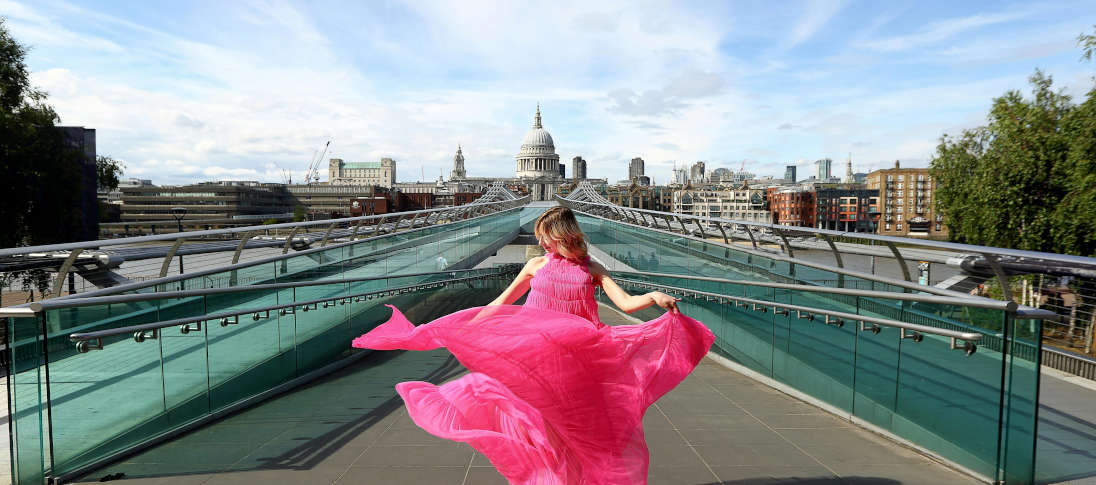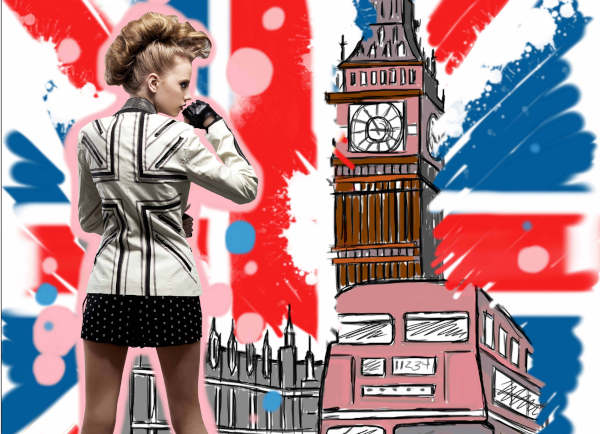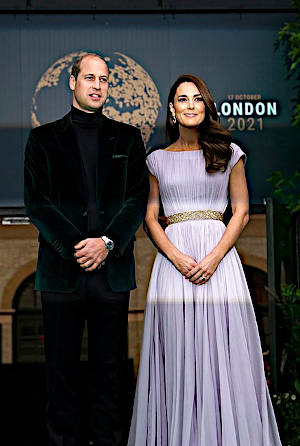
London fashion
The upsides and the downsides
Linguapress intermediate
For centuries London has been a capital of style. In recent decades
however, it
has become an international capital of high fashion. Some people might
call it the
international capital of fashion
.
The darker side of fashion...
"Fashion" - or in other words, the "clothing industry", is the fourth biggest industry in the world. It makes up 2% of the global economy.It provides millions of jobs worldwide... BUT
Unfortunately many people who make clothes for rich countries live in poor countries, and many of them work in bad conditions, for very low pay.
More alarmingly the "fashion" industry is very bad for the environment, the world around us. While warnings about climate change are becoming ever more urgent, the clothing industry just keeps growing. According to Earth.org, 92 million tons of used clothes end up each year in "landfill" (they are buried in the ground, or just left on the surface).
Even natural fibres, like cotton, are bad for the environment . Producing cotton requires huge volumes of water.... At least 8000 litres of water per kilo of cotton, and more than twice as much in countries with less efficient irrigation systems.
So how can you help? There are two ways to start: buy less clothes.. you don't need to have the latest fashion every six months. Buy better quality clothes; they may be more expensive, but generally they last longer, and look good for longer.
New generations of designers keep coming on too. London's "University of the Arts" is the largest university of the arts in Europe; its London College of Fashion and Central St. Martin's college are two of the world's most prestigious and dynamic colleges of fashion and design.
Once, "London fashion" meant men in suits, bowler hats, and rolled umbrellas; yet times have changed, and although the "suit and tie" is still a common uniform for men working in city offices, even that is changing. Indeed many firms in London now have a "mufti day" once a week, or once a month, when employees can wear what they like - jeans and trainers or whatever - instead of their traditional suits.
According to the latest surveys, traditional suits are now disappearing fast, and "dress as you want" is becoming the rule. However top businessmen and civil servants will continue dressing in suits for years to come - if not for ever - while on the streets, London fashions keep changing fast.... and first. That, of course, is what fashion is all about.
There's fashion... and style

Classic chic. Prince William and Kate in 2021
Two hundred years ago, English fashions were admired and copied all over Europe and North America! Fashion however was rather different in those days, as it was only for aristocrats and other wealthy people, not for ordinary people. All clothes were made by hand, or "made to measure", and there was no such thing as "off-the-peg" fashion. In England, the most fashionable tailors worked in a London street called Savile Row, and the tailors of Savile Row have long been reputed among the best in the world.
Even today Savile Row tailors enjoy a reputation second to none, and some of them regularly travel the world, making the best suits for important businessmen, royalty, millionnaires, celebrities, diplomats and politicians in many countries. For those who cannot afford a Savile Row tailor, shops and brands like Burberry take their timeless British styles and classic designs to cities all over the world. But is this "classic chic" the same as "fashion"? Some people would perhaps say "no".
Linguapress has more intermediate resources on clothes and fashion. See:
- Discussion. Are you a brand slave?
- Fashion history: The story of Blue Jeans.
- Interactive crossword: Clothes crossword.
WORD GUIDE
event: occasion, show - in charge of: responsible for - off the peg: instantly available in a shop, ready to wear - keep: continue - prestigious: respected, important - suit: matching jacket and trousers - bowler hat : a round hard black hat - mufti: civilian clothes, whatever you want to wear - survey: study - civil servant: government employee - tailor: person who makes clothes - enjoy: benefit from - brand: make, commercial name, label
Worksheet
Interactive multiple choice exercise
Conjunctions, connectors and other key words.Choose the correct option for each of the eighteen drop-down boxes below.
Most of the options concern connecting words, which relate one part of a document to another. Connectors are very important words, as they determine the relation between different clauses... addition, contrast, confirmation, an example, and so on.
many of the
world's top
fashion designers now work in London, some of London's top
designers,
John
Galliano, are now in
charge of major
collections in Paris and New York. Vivienne Westwood,... is
perhaps the most significant fashion designer
of the past 50 years.
Stella
McCartney, the daughter of Paul
McCartney, is the world's leading designer of eco-friendly
fashion.
Once, "London fashion" meant men in suits, bowler hats, and rolled umbrellas; times have changed, and the "suit and tie" is a common uniform for men working in city offices, even that is changing. many firms in London now have a "mufti day" once a week, or once a month, employees can wear they like - jeans and trainers or whatever - their traditional suits.
the latest surveys, traditional suits are now disappearing fast, "dress you want" is becoming the rule. top businessmen and civil servants will continue dressing in suits for years to come - for - on the streets, London fashions keep changing fast.... and first. That, of course, is fashion is all about.
Once, "London fashion" meant men in suits, bowler hats, and rolled umbrellas; times have changed, and the "suit and tie" is a common uniform for men working in city offices, even that is changing. many firms in London now have a "mufti day" once a week, or once a month, employees can wear they like - jeans and trainers or whatever - their traditional suits.
the latest surveys, traditional suits are now disappearing fast, "dress you want" is becoming the rule. top businessmen and civil servants will continue dressing in suits for years to come - for - on the streets, London fashions keep changing fast.... and first. That, of course, is fashion is all about.
For teachers:
Grammar point: conjunctions, connectors. This text is rich in conjunctions and other connectors. As well as simple coordinating conjunctions and but, as and yet, and subordinating conjunctions such as although and though, while, and when, there are conjunctive adverbs like however, meanwhile or indeed. Make sure that students understand their meanings and use.
The multiple-choice exercise has been carefully thought through so that in each box where conjunctions or connectors are listed, only one is correct. Obviously, other choices will be gramatically correct, for instance the first sentence would remain gramatically correct whether the student chose as, because, while or until (though a bit strange with until); but if the wrong choice is selected, then the meaning of the sentence changes, as the subordinate clause no longer relates to the main clause in the same way.
Note how conjunctive adverbs, like however, can be moved around in a clause, whereas conjunctions must stand at the start of the clause.
For a full explanation of conjunctions and connectors, with lots of clear examples, see A Descriptive Grammar of English, section 3.3.
Vocabulary: You might like to ask students to pick out all the vocabulary relating to fashion and clothing that appears in this text. Note the useful expression "off-the-peg"... and its antonym, which is also in the text. Brainstorm with students for more clothes and fashion vocabulary. For a vocabulary game, see the intermediate interactive clothes crossword.
Discussion. The fashion industry has come in for a lot of criticism in the past few years, not just for the working conditions that exist in many "sweat shop" factories in developing countries, but also for its staggering - yet little reported - environmental impact. According to the BBC and other reliable resources, the worldwide fashion industry generates about 8-10% of global CO2 emissions, and nearly 20% of wastewater. According to the United Nations, the manufacturing of a single pair of jeans requires between 7.5 and 10 tonnes of water, mostly of it used in the watering of the fields in which the cotton is produced
Other ideas?
EFL / ESOL teachers: Help develop this resource by contributing extra teaching materials or exercises.
To contribute click here for further details
Copyright notice.

If you like this page and want to share it with others, just share a link, don't copy.
This teaching resource is © copyright Linguapress 2022.
Republication on other websites or in print is not authorised
Copying permitted for personal study, or by teachers for use with their students.
| Linguapress home | English grammar | Discover Britain |



